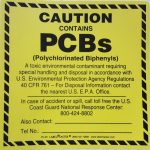Before we begin…
The content of this Q&A is based on the Hazardous Materials Regulations (HMR) of the Pipeline and Hazardous Materials Safety Administration within the U.S. Department of Transportation (USDOT/PHMSA).
PCBs – or Polychlorinated biphenyls – are a highly toxic product whose production was banned by United States federal law in 1978, and by the Stockholm Convention on Persistent Organic Pollutants in 2001. It is an organic chlorine compound.
RCRA is the Resource Conservation and Recovery Act. It is the primary source of law upon which the Federal hazardous waste regulations of the U.S. Environmental Protection Agency (USEPA) are based.
Like this article? Subscribe to my Monthly Newsletter No marketing emails! |
The Question (11.21.20):
Subject: DOT training for PCB
Message Body:
Is DOT hazmat training required to sign the hazardous waste manifest when it is used for PCB transportation pursuant to 40 CFR 761.207? I understand it is for RCRA hazardous waste shipments.

My Answer (11.30.20):
I will try to answer your question below.
- HazMat Employee training is required for any person with a direct affect on the safe transport of HazMat. This includes preparation, review, and signing / certifying of a hazardous material shipping paper.
- A uniform hazardous waste manifest is a type of hazardous material shipping paper.
- A hazardous waste subject to the regulations of the USEPA is one type of a hazardous material regulated by USDOT/PHMSA.
- USDOT/PHMSA defines a hazardous waste at 49 CFR 171.8 as a material subject to the Hazardous Waste Manifest Requirements of the USEPA at 40 CFR part 262.
- The Hazardous Waste Manifest Requirements of 40 CFR part 262 apply solely to a large quantity generator of hazardous waste (LQG) and a small quantity generator of hazardous waste (SQG). A very small quantity generator of hazardous waste (VSQG) – formerly conditionally exempt small quantity generator of hazardous waste (CESQG) – is not subject to 40 CFR part 262.
Not sure of your hazardous waste generator category? |
- The USDOT does not extend applicability to the manifest requirements of 40 CFR 761.207 which is the manifest general requirements for PCB waste.
So…
- The use of the uniform hazardous waste manifest alone does not make the shipment subject to the HMR and therefore require HazMat Employee training.
However…
- PCB waste may be a HazMat for other reasons:
- It may contain a concentration of PCBs and be transported in a manner that classifies it as a marine pollutant. Generally speaking this would require a concentration of PCBs in solution of 1% or more and the waste must be transported by vessel or in a bulk packaging by highway or rail. Read: What is a marine pollutant?
- It may contain a concentration and weight of PCBs in a single container that classifies it as a RQ of a hazardous substance. In general, this will require a PCB concentration of 20 parts per million or more and a quantity of 1 pound or more in a single package.
- So, more information is required before I can fully answer your question. At a minimum I require:
- The concentration of PCB in the – I presume – oil.
- The size and type of packaging.
- The mode of transport.
Regardless, HazMat Employee training is always a good idea!
Please contact me with any other questions.
Daniels Training Services, Inc. 815.821.1550 |
No reply.
I did not hear anymore from that questioner. Perhaps my answer was enough? The Hazardous Materials Regulations of USDOT/PHMSA can be difficult to comply with all on their own. If the transportation involves a waste subject to USEPA regulations – or those of your state – it can become even more complicated. Make sure you understand the relationship between the Federal regulations of the USDOT/PHMSA and USEPA when arranging for the off-site transportation of waste.
